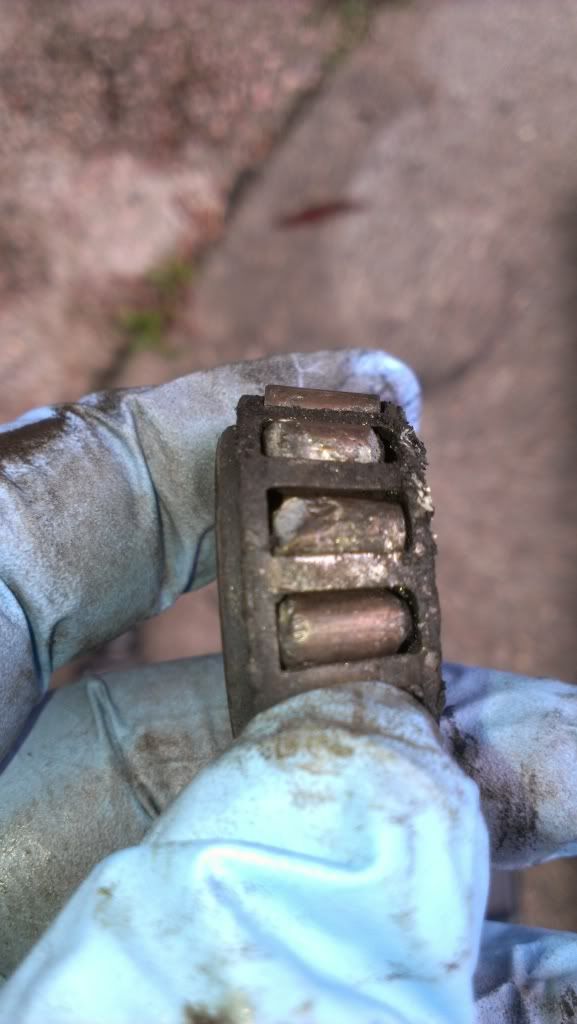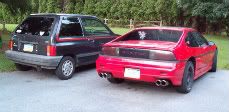Ok so this thing as giving me a hard time! When I bought the car the RR wheel bearings were so shot that the wheel wasn't even sitting strait on the spindle. No big deal, I thought, Ive done plenty of bearings in the past. The spindle was actually still in good shape as far as I could tell so I ordered just bearings (Timken) and the seal. I ended up doing both sides (all 4) on the rear just to make sure they were good. Well after about 4,000 miles I started hearing noise and went around and felt each wheel and now the LR was quite hot. I pulled it apart and the outer bearing was shot.. here is a pic...

That is pretty terrible for 4,000 miles!!! The inner bearing actually seems good. So I ordered a second round of bearings/seals for both sides. I replaced the left side and was sure to follow the FSM exactly for pre-load specs. I wasn't confident I had done this right on the first round of bearings! I think the first time I may have done it wrong in a way that left too little pre-load. I drove it about 20 miles and it still felt pretty worm compared to the right side. I decided to check the right side since I had new bearings for it as well. It looked like it was still pretty good but was definitely wearing funny and soon to start failing I'm sure. The inner was good again but the outer had a small grove along the outer edge of the race (the wider end if that helps). So I replaced them as well. I drove about 20 more miles and the results were as follows: both front wheels were what I would expect for disc brake heat (hot but not really hot enough to hurt ) RR was warm (probably what i would expect from a rear drum brake wheel) LR was real hot (hotter than the front and ALMOST hot enough to burn your hand hmmmmmm) So my concern is something is obviously still causing more than normal heat on the LR. Im about 99% sure its not brake drag. I really need some experts here, I have to get this solved soon as I drive this thing 100 miles a day to work.
) RR was warm (probably what i would expect from a rear drum brake wheel) LR was real hot (hotter than the front and ALMOST hot enough to burn your hand hmmmmmm) So my concern is something is obviously still causing more than normal heat on the LR. Im about 99% sure its not brake drag. I really need some experts here, I have to get this solved soon as I drive this thing 100 miles a day to work.
This is what I THINK I have covered:
I bought a bearing packer this time to ensure proper packing!
Races appear to be seated properly.
Spindles look good.
Plenty of high temp grease.
Used a paint pen to mark axle nuts to confirm there not backing off.
Pre-load ( torqued to 20 ft/lbs while spinning the drum, backed it of to finger tight, measured seal drag at about .5 in/lbs, set pre-load to 3 in/lbs.) FSM says 1.3-4.3 in/lbs plus seal drag so my range should have been 1.9-4.9 and I'm at 3.
Everyone's thoughts are really appreciated!!!
Also...where does this shim go, and is it even part of a Festiva. The PO said it had to have them or it would eat bearings, but every thing else he said about the car was completely fabricated or wrong so I don't really consider his suggestions anymore! My RR is slightly canted in at the bottom and I do think this MAY be the solution.


That is pretty terrible for 4,000 miles!!! The inner bearing actually seems good. So I ordered a second round of bearings/seals for both sides. I replaced the left side and was sure to follow the FSM exactly for pre-load specs. I wasn't confident I had done this right on the first round of bearings! I think the first time I may have done it wrong in a way that left too little pre-load. I drove it about 20 miles and it still felt pretty worm compared to the right side. I decided to check the right side since I had new bearings for it as well. It looked like it was still pretty good but was definitely wearing funny and soon to start failing I'm sure. The inner was good again but the outer had a small grove along the outer edge of the race (the wider end if that helps). So I replaced them as well. I drove about 20 more miles and the results were as follows: both front wheels were what I would expect for disc brake heat (hot but not really hot enough to hurt
 ) RR was warm (probably what i would expect from a rear drum brake wheel) LR was real hot (hotter than the front and ALMOST hot enough to burn your hand hmmmmmm) So my concern is something is obviously still causing more than normal heat on the LR. Im about 99% sure its not brake drag. I really need some experts here, I have to get this solved soon as I drive this thing 100 miles a day to work.
) RR was warm (probably what i would expect from a rear drum brake wheel) LR was real hot (hotter than the front and ALMOST hot enough to burn your hand hmmmmmm) So my concern is something is obviously still causing more than normal heat on the LR. Im about 99% sure its not brake drag. I really need some experts here, I have to get this solved soon as I drive this thing 100 miles a day to work.This is what I THINK I have covered:
I bought a bearing packer this time to ensure proper packing!
Races appear to be seated properly.
Spindles look good.
Plenty of high temp grease.
Used a paint pen to mark axle nuts to confirm there not backing off.
Pre-load ( torqued to 20 ft/lbs while spinning the drum, backed it of to finger tight, measured seal drag at about .5 in/lbs, set pre-load to 3 in/lbs.) FSM says 1.3-4.3 in/lbs plus seal drag so my range should have been 1.9-4.9 and I'm at 3.
Everyone's thoughts are really appreciated!!!
Also...where does this shim go, and is it even part of a Festiva. The PO said it had to have them or it would eat bearings, but every thing else he said about the car was completely fabricated or wrong so I don't really consider his suggestions anymore! My RR is slightly canted in at the bottom and I do think this MAY be the solution.








Comment